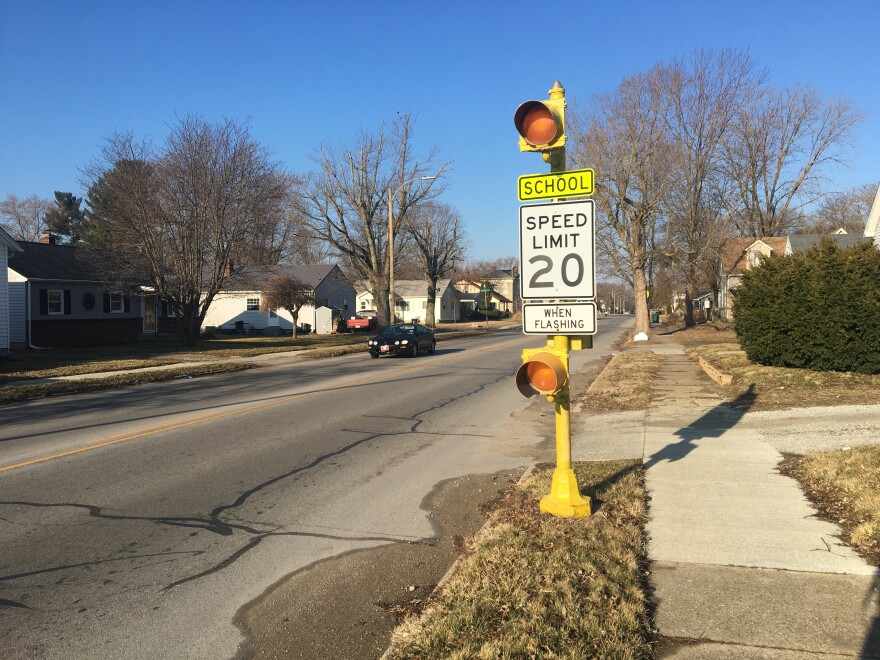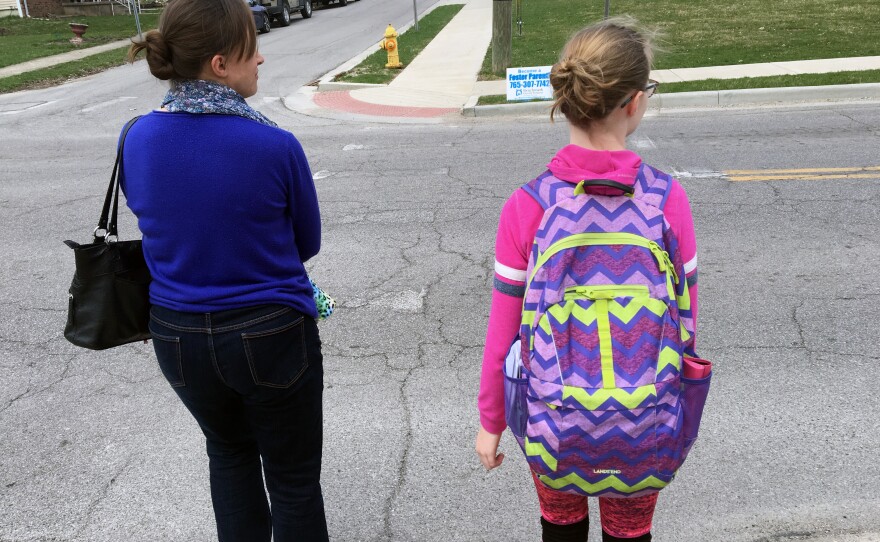Crawfordsville is making an effort to improve walkability and safety around town, starting with its schools. The city is updating school zone speed limits and locations for the first time in 35 years.
Ten-year old Hope Taylor takes the same route home from Mollie B. Hoover Elementary School almost every day.
“I cross the train tracks, and then I cross – there’s a stop at the street but there aren’t any stop signs, so it’s really up to me to judge,” Hope says. “And it’s not a very busy street either, so there’s really not very often any cars coming.”
Taylor and her Girl Scout troop are working on a project about sidewalk quality in Crawfordsville. They’re checking for cracks, height differences between slabs, and potholes.
Sidewalk maintenance in Crawfordsville is the responsibility of homeowners, not the city. Some residents have been good at preserving them, but others?

“There’s a patch about that big where you can see the sidewalk, and then the rest is like, dirt and grass,” Hope says.
Taylor looks for examples of poor maintenance while she’s walking home from school, a distance of about three quarters of a mile.
“Once I get past the middle school, the sidewalks kind of go down,” she says.
But there may be fewer people monitoring the situation, because far fewer kids walk to school than in years past. Of the nearly 2,600 students in Crawfordsville Community Schools, district officials say Hope Taylor is one of fewer than 100 who regularly walks.
Superintendent Scott Bowling says that number used to be a lot higher; he says the district was designed for walkers.
“It was intentionally done that way because when consolidation happened in the 60s -- we weren’t going to have buses. We were going to be a walking district.”
Bowling says 60-70 percent of students are bussed now, mostly because parents are worried about safety.
“Some terrible things have happened, both with traffic accidents and with things that are even worse,” Bowling says. “So parents are much more cautious.”
Hope’s mother, Ann, says she’s comfortable letting all of her kids walk to the elementary and middle schools. But she says recent traffic accidents in the area have sparked concerns among parents about safety.
“It doesn’t take long for that to spread in a small community,” she says.
Because of the drop in student walkers, Crawfordsville officials contend some school zones and student crossings are no longer necessary.
The city council passed an ordinance eliminating some school zones, and increasing the speed in others.
Mayor Todd Barton says those zones haven’t been updated since 1984.

“Some of those existing zones really don’t pass legal muster. They’re not close to a school and you know our police department really has not enforced those for a very long time because they know that they don’t fit, they don’t make sense with current state statute.”
Crawfordsville Police Chief Mike Norman says they have extra patrols out at the beginning and end of school. He claims speeding isn’t overly common, but changing the ordinance will still make a difference.
“Being in compliance with state statutes will allow us enforce that much easier than we would have had an opportunity to enforce it before,” he says.
Ann Taylor also thinks raising the speed limit won’t make much of a difference – because people regularly do speed in school zones.
“I don’t know how many people actually drive 20 on this road anyway. As you hear cars go by, they’re definitely going faster than 20,” she says.
State law requires a school zone be adjacent to a school, and cities need to do an engineering study to drop speed limits below 25 mph.
Barton says they’ll remove the zones that don’t border a school. And any remaining zones with 20 mph limits will go up to 25.
“There may be some areas that we look at that 20, that additional lower speed limit. We wanted to get this in place first," Barton says. "We’re not opposed to doing that, we just want to get started and see what happens.”
Hope Taylor walks through two school zones on her way home. One of them will be removed; the speed limit will go up in the other.
Her mom, Ann, says she’s not sure that impacts her decision to let Hope walk.
“I have a feeling drivers will appreciate it, but I don’t know what the difference on a kid being hit at 25 miles per hour versus 20 miles per hour would be,” she says. “I don’t think either would be very good.”
And she’s not wrong – but a car going 25 mph hits a child with 55 percent more energy than one going 20 mph.








